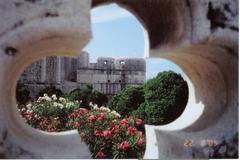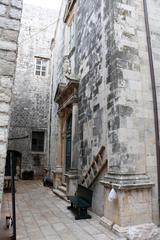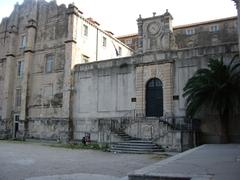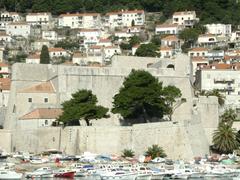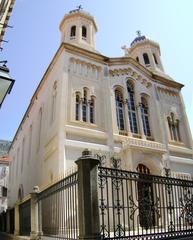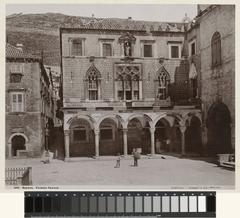
Pile Gate Dubrovnik: Visiting Hours, Tickets & Comprehensive Historical Guide
Date: 04/07/2025
Introduction
Pile Gate (“Vrata od Pila”) stands as the principal western entrance to Dubrovnik’s UNESCO World Heritage Old Town, serving for centuries as both a functional gateway and a powerful symbol of the city’s resilience and cultural identity. Built as part of the Republic of Ragusa’s formidable defense system, Pile Gate blends Gothic, Renaissance, and Baroque architectural influences and welcomes millions of visitors each year eager to explore the city’s rich medieval heritage (walkindubrovnik.com, dubrovnik-travel.net, Visit Dubrovnik).
Open 24/7 with free public access, Pile Gate is not only an accessible entry point but also a cultural hub, positioned at the heart of Dubrovnik’s vibrant community and only steps away from key attractions such as the Stradun promenade, City Walls, and Fort Lovrijenac. Its historical significance is further elevated by appearances in popular culture, including HBO’s “Game of Thrones,” where it served as the entrance to King’s Landing.
This guide offers all the essential information for visiting Pile Gate, including hours, ticketing, accessibility, historical background, and practical tips to ensure you enjoy one of Croatia’s most iconic landmarks.
Table of Contents
- Introduction
- History and Architectural Evolution
- Visiting Pile Gate
- Cultural and Social Significance
- Key Features to Explore
- Visuals and Virtual Tours
- Frequently Asked Questions (FAQs)
- Practical Information and Nearby Attractions
- Conclusion and Recommendations
- References
History and Architectural Evolution
Medieval Foundations
Originating in the 15th century, Pile Gate was integral to the Republic of Ragusa’s defensive network. The original entrance featured a wooden drawbridge and moat, designed to be raised nightly as a security measure against invaders. The name “Pile” is derived from the Greek word “pylaj,” meaning “gate,” alluding to Dubrovnik’s Mediterranean connections (dubrovnik-travel.net).
Renaissance Expansion
In 1537, facing new threats and evolving military technology, the city replaced the wooden bridge with a robust stone structure and enhanced the gate’s fortifications. The complex now comprises two gates—an outer and an inner—forming a narrow, defensible passage. The inner gate, dating to 1460, features a pointed Gothic arch, while the outer gate’s Renaissance arch and decorative stonework reflect Dubrovnik’s openness to artistic trends from Italy and beyond (Visit Dubrovnik).
Symbolic and Strategic Role
Flanked by the Bokar and Lovrijenac forts, Pile Gate served as a key defensive point and ceremonial threshold. It witnessed pivotal moments including the 1806 entry of Napoleon’s troops, which ended the Republic of Ragusa (walkindubrovnik.com). The gate’s nightly drawbridge ritual once symbolized the city’s vigilance, while above the main arch, the statue of St. Blaise, Dubrovnik’s patron saint, has long served as a symbol of spiritual protection and civic pride.
Restoration and Preservation
Pile Gate has survived earthquakes, wars—including shelling during the Croatian War of Independence (1991–1995)—and centuries of change. Major restoration efforts have preserved its medieval character and artistic flourishes. A commemorative plaque inside the gate honors both the city’s resilience and the teams that have restored it to its former glory (historyhit.com).
Visiting Pile Gate
Hours and Entry
- Open: 24/7, year-round
- Admission: Free; Pile Gate is a public thoroughfare and does not require a ticket for entry.
- Nearby Ticketed Sites: City Walls, Fort Lovrijenac, and select museums require paid admission (Lonely Planet).
Tickets and Guided Tours
- City Walls Ticket: €35 (2025 price), includes Fort Lovrijenac; can be purchased at Pile Gate or online.
- Dubrovnik Pass: Bundles access to the City Walls, museums, and public transport for savings and convenience.
- Guided Tours: Numerous walking tours start at Pile Gate and offer historical insights and exclusive access to select sites. Booking in advance is recommended during peak season.
Accessibility
- Physical Access: Pile Gate is the most accessible entrance to Old Town, with ramps and step-free access, though some cobbled streets and steps remain inside the city (dubrovnik-travel.net).
- Facilities: Public restrooms and ATMs are available near the gate; the area is stroller- and wheelchair-friendly, but some attractions have limited accessibility.
Travel Tips
- Best Times: Visit early morning or late afternoon to avoid crowds, especially during cruise ship arrivals (10:00–16:00).
- Footwear: Wear comfortable, non-slip shoes due to smooth limestone paving.
- Tickets: Purchase City Walls or Dubrovnik Pass tickets online to skip lines.
- Essentials: Bring water, sun protection in summer, and rain gear in winter months.
- Etiquette: Respect heritage rules, dress modestly in churches, and maintain quiet in residential Old Town.
Cultural and Social Significance
Pile Gate is more than a defensive structure—it is the symbolic threshold to Dubrovnik’s soul. For centuries, processions, festivals (including the UNESCO-listed Festival of St. Blaise), and daily rituals centered around the gate. The statue of St. Blaise holding a model of the city above the arch reinforces Dubrovnik’s religious and civic identity (cars-scanner.com, ermakvagus.com).
The surrounding Brsalje area is a bustling hub for locals and visitors alike, and Pile Gate’s recent fame as a “Game of Thrones” filming location has only added to its international allure (worldtraveleye.com).
Key Features to Explore
- Drawbridge and Moat: Remnants of the original drawbridge mechanism and the now-landscaped moat provide a glimpse into medieval engineering (Atlas Obscura).
- Statues of St. Blaise: Both Renaissance and modern iterations grace the gate, underscoring Dubrovnik’s spiritual heritage (walkindubrovnik.com).
- Defensive Architecture: Look for machicolations (openings for defensive fire), thick stone walls, and the strategic positioning between major forts.
- Gatehouse and Guardrooms: Inside the complex, observe the original layout of guardrooms and a small chapel dedicated to St. Blaise (Dubrovnik City Walls).
- Access to Stradun: The gate opens directly onto Stradun, Dubrovnik’s lively main street.
Visuals and Virtual Tours
- Photography Spots: The stone bridge, gate arches, and statue of St. Blaise are ideal for photos, particularly at sunrise or sunset.
- Virtual Tours: High-quality images and virtual walkthroughs are available on official tourism websites (walkindubrovnik.com).
- Alt Text Suggestions: “Pile Gate Dubrovnik entrance,” “Medieval stone bridge at Pile Gate,” “Statue of St. Blaise above Pile Gate.”
Frequently Asked Questions (FAQs)
Q: What are Pile Gate’s visiting hours?
A: Pile Gate is open 24/7, year-round, with free public access.
Q: Is there an entrance fee to pass through Pile Gate?
A: No, entry is free. Tickets are only required for nearby attractions like the City Walls and Fort Lovrijenac.
Q: Are guided tours available starting at Pile Gate?
A: Yes, a variety of walking tours begin at Pile Gate and can be booked locally or online.
Q: Is Pile Gate wheelchair accessible?
A: The gate itself is accessible, but some Old Town streets and historic sites may present challenges.
Q: What is the best time to visit?
A: Early mornings or late afternoons for a quieter experience and softer light for photography.
Practical Information and Nearby Attractions
-
Location: At the western end of Stradun, central to public transport routes (Lonely Planet).
-
Nearby Attractions:
- City Walls: Entrance adjacent to Pile Gate; circuit offers panoramic views.
- Fort Lovrijenac: Access included with City Walls ticket, known for sweeping vistas.
- Stradun: Old Town’s main promenade, lined with shops and cafés.
- Rector’s Palace, Franciscan Monastery, Maritime Museum: All within walking distance.
-
Facilities: Public restrooms (small fee), ATMs, luggage storage nearby.
-
Transportation:
- Bus: Central bus lines terminate at Pile Gate.
- Taxi: Ranks nearby, though traffic can be heavy.
- Walking: Old Town is best explored on foot.
Conclusion and Recommendations
Pile Gate is more than a historic entrance; it is a living symbol of Dubrovnik’s endurance, beauty, and vibrant community. Free and open at all hours, it provides an unparalleled gateway into the Old Town’s medieval charm and bustling daily life. Enhance your visit by arriving early or late in the day, booking a guided tour for in-depth historical context, and using the Dubrovnik Pass for access to top attractions.
Make Pile Gate your starting point to discover the wonders of Dubrovnik—whether you’re capturing photos from the stone bridge, exploring ancient fortifications, or simply soaking in the lively atmosphere. For real-time updates, self-guided tours, and local tips, download the Audiala app and follow official channels for the latest on cultural events and travel advice.
Begin your Dubrovnik adventure at Pile Gate—the gateway to centuries of history, culture, and unforgettable memories (dubrovnikcity.com, historyhit.com, walkindubrovnik.com).
References
- Pile Gate Dubrovnik: Visiting Hours, Tickets & Historical Guide to Dubrovnik’s Iconic Entrance, 2025, Walk in Dubrovnik
- Pile Gate Dubrovnik, 2025, Dubrovnik Travel
- Pile Gate Dubrovnik: Visiting Hours, Tickets, and Architectural Highlights, 2025, Dubrovnik Tourist Board
- Pile Gate Dubrovnik, 2025, Visit Dubrovnik
- Pile Gate: Visiting Hours, Tickets, and Cultural Significance of Dubrovnik’s Iconic Historical Site, 2025, Cars Scanner Blog
- Pile Gate Dubrovnik: Visiting Hours, Tickets, and Tips for Exploring Dubrovnik’s Historic Entrance, 2025, Lonely Planet
- Pile Gate, 2025, History Hit
- Pile Gate Dubrovnik, 2025, Dubrovnik City


